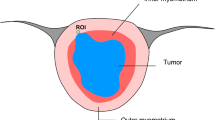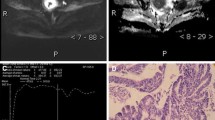Abstract
Purpose
The present study aimed to evaluate the relationship between tumor volume and apparent diffusion coefficient (ADC) in preoperative magnetic resonance imaging and deep myometrial invasion, tumor grade, and lymphovascular space invasion (LVSI) in patients with early-stage endometrial cancer.
Methods
The study included 73 patients diagnosed with early-stage endometrial cancer based on histopathological examination between May 2014 and July 2019. Receiver operating characteristic (ROC) curve analysis was used to estimate the accuracy of ADC and tumor volume in predicting the LVSI, the depth of myometrial invasion (DMI), and the histopathological tumor grade in these patients.
Results
The areas under the ROC curves (AUCs) of ADC and tumor volume in predicting LVI, DMI, and high tumor grade were significantly greater than those for superficial myometrial invasion and low-grade tumors. The ROC analysis revealed that higher tumor volume was significantly associated with the prediction of DMI and tumor grade (p = 0.002 and p = 0.015). The corresponding cut-off values of tumor volume were > 7.12 and > 9.38 mL. The sensitivity of ADC in predicting DMI was higher than its sensitivity in predicting LVSI and grade 1 tumors. Furthermore, tumor volume was significantly associated with the prediction of DMI and tumor grade.
Conclusion
In the absence of pathological pelvic lymph nodes in early-stage endometrial cancer, tumor volume in DWI sequences determines the active tumor load and tumor aggressiveness. Furthermore, a low ADC indicates deep myometrial invasion and helps differentiate stage IA and stage IB tumors.
Zusammenfassung
Ziel
Ziel der vorliegenden Studie war es, den Zusammenhang zwischen dem Tumorvolumen und dem apparenten Diffusionskoeffizienten (ADC) bei der präoperativen Magnetresonanztomographie zu beurteilen sowie tiefer myometrialer Invasion, Tumorgrading und lymphovaskulärer Invasion bei Patientinnen mit Endometriumkarzinom im Frühstadium.
Methoden
In die Studie wurden 73 Patientinnen zwischen Mai 2014 und Juli 2019 mit der auf einer histopathologischen Untersuchung basierenden Diagnose eines Endometriumkarzinoms im Frühstadium einbezogen. Die Receiver-Operating-Characteristic(ROC)-Curve-Analyse wurde eingesetzt, um die Genauigkeit des ADC und des Tumorvolumens bei der Vorhersage der Invasion in den lymphovaskulären Raum („lymphovascular space invasion“ [LVSI]) abzuschätzen, die Tiefe der myometrialen Invasion („depth of myometrial invasion“ [DMI]) und das histopathologische Tumorgrading bei diesen Patientinnen.
Ergebnisse
Die Flächen unter den ROC-Kurven („area under the curve“ [AUC]) von ADC und Tumorvolumen bei der Vorhersage von LVI, DMI und hohem Tumorgrading waren signifikant größer als die Flächen für oberflächliche myometriale Invasion und Low-Grade-Tumoren. Die ROC-Analyse ergab, dass ein höheres Tumorvolumen in signifikanter Weise mit der Vorhersage von DMI und Tumorgrading einherging (p = 0,002 bzw. p = 0,015). Die entsprechenden Grenzwerte des Tumorvolumens betrugen > 7,12 bzw. > 9,38 ml. Die Sensitivität des ADC bei der Vorhersage der DMI war höher als seine Sensitivität bei der Vorhersage von LVSI und Grad-1-Tumoren. Darüber hinaus stand das Tumorvolumen in signifikanter Weise mit der Vorhersage von DMI und Tumorgrading in Zusammenhang.
Schlussfolgerung
Sind keine pathologischen Beckenlymphknoten beim Endometriumkarzinom im Frühstadium vorhanden, so bestimmt das Tumorvolumen in DWI-Sequenzen die aktive Tumorlast und Tumoraggressivität. Außerdem zeigt ein geringer ADC eine tiefe myometriale Invasion an und hilft dabei, Tumoren im Stadium IA und IB zu differenzieren



Similar content being viewed by others
References
Beddy P, O’Neill AC, Yamamoto AK, et al (2012) FIGO staging system for endometrial cancer: Added benefits of MR imaging. Radiographics 32:241–254. https://doi.org/10.1148/rg.321115045
Bourgioti C, Chatoupis K, Tzavara C, et al (2016) Predictive ability of maximal tumor diameter on MRI for high-risk endometrial cancer. Abdom Radiol 41:2484–2495. https://doi.org/10.1007/s00261-016-0927-0
Chan JK, Kapp DS (2007) Role of complete lymphadenectomy in endometrioid uterine cancer. Lancet Oncol 8:831–841. https://doi.org/10.1016/S1470-2045(07)70275-9
Cohen JF, Korevaar DA, Altman DG, et al (2016) STARD 2015 guidelines for reporting diagnostic accuracy studies: Explanation and elaboration. BMJ Open 6:e012799. https://doi.org/10.1136/bmjopen-2016-012799
DeLong ER, DeLong DM, Clarke-Pearson DL (1988) Comparing the Areas under Two or More Correlated Receiver Operating Characteristic Curves: A Nonparametric Approach. Biometrics 44:837. https://doi.org/10.2307/2531595
Dos Reis R, Burzawa JK, Tsunoda AT, et al (2015) Lymphovascular space invasion portends poor prognosis in low-risk endometrial cancer. Int J Gynecol Cancer 25:1292–1299. https://doi.org/10.1097/IGC.0000000000000490
Dowdy SC, Borah BJ, Bakkum-Gamez JN, et al (2012) Prospective assessment of survival, morbidity, and cost associated with lymphadenectomy in low-risk endometrial cancer. Gynecol Oncol 127:5–10. https://doi.org/10.1016/j.ygyno.2012.06.035
Fujii S, Matsusue E, Kigawa J, et al (2008) Diagnostic accuracy of the apparent diffusion coefficient in differentiating benign from malignant uterine endometrial cavity lesions: Initial results. Eur Radiol 18:384–389. https://doi.org/10.1007/s00330-007-0769-9
Husby JA, Salvesen O, Magnussen IJ, et al (2015) Tumour apparent diffusion coefficient is associated with depth of myometrial invasion and is negatively correlated to tumour volume in endometrial carcinomas. Clin Radiol 70:487–494
Kishimoto K, Tajima S, Maeda I, et al (2016) Endometrial cancer: Correlation of apparent diffusion coefficient (ADC) with tumor cellularity and tumor grade. Acta radiol 57:1021–1028. https://doi.org/10.1177/0284185115612249
Mainenti PP, Pizzuti LM, Segreto S, et al (2016) Diffusion volume (DV) measurement in endometrial and cervical cancer: A new MRI parameter in the evaluation of the tumor grading and the risk classification. Eur J Radiol 85:113–124. https://doi.org/10.1016/j.ejrad.2015.10.014
Neal SA, Graybill WS, Garrett-Mayer E, et al (2016) Lymphovascular space invasion in uterine corpus cancer: What is its prognostic significance in the absence of lymph node metastases? Gynecol Oncol 142:278–282. https://doi.org/10.1016/j.ygyno.2016.05.037
Nougaret S, Lakhman Y, Vargas HA, et al (2017) From Staging to Prognostication: Achievements and Challenges of MR Imaging in the Assessment of Endometrial Cancer. Magn Reson Imaging Clin N Am 25: 611–633. https://doi.org/10.1016/j.mric.2017.03.010
Nougaret S, Reinhold C, Alsharif SS, et al (2015) Endometrial cancer: Combined MR volumetry and diffusion-weighted imaging for assessment of myometrial and lymphovascular invasion and tumor grade. Radiology 276:797–808. https://doi.org/10.1148/radiol.15141212
Panici PB, Basile S, Maneschi F, et al (2008) Systematic Pelvic Lymphadenectomy vs No Lymphadenectomy in Early-Stage Endometrial Carcinoma: Randomized Clinical Trial. JNCI J Natl Cancer Inst 100:1707–1716. https://doi.org/10.1093/jnci/djn397
Rathod PS, Shakuntala PN, Pallavi VR, et al (2014) The Risk and Pattern of Pelvic and Para Aortic Lymph Nodal Metastasis in Patients with Intermediate and High Risk Endometrial Cancer. Indian J Surg Oncol 5:109–114. https://doi.org/10.1007/s13193-014-0303-x
Sahin H, Sarioglu FC, Bagci M, et al (2018) Preoperative Magnetic Resonance Volumetry in Predicting Myometrial Invasion, Lymphovascular Space Invasion, and Tumor Grade: Is It Valuable in International Federation of Gynecology and Obstetrics Stage I Endometrial Cancer? Int J Gynecol Cancer 28:666–674. https://doi.org/10.1097/IGC.0000000000001208
Shen S-H, Chiou Y-Y, Wang J-H, et al (2008) Diffusion-Weighted Single-Shot Echo-Planar Imaging with Parallel Technique in Assessment of Endometrial Cancer. Am J Roentgenol 190:481–488. https://doi.org/10.2214/AJR.07.2155
Singh N, Hirschowitz L, Zaino R, et al (2019) Pathologic Prognostic Factors in Endometrial Carcinoma (Other Than Tumor Type and Grade). Int J Gynecol Pathol 38:93–113. https://doi.org/10.1097/PGP.0000000000000524
Tamai K, Koyama T, Saga T, et al (2007) Diffusion-weighted MR imaging of uterine endometrial cancer. J Magn Reson Imaging 26:682–687. https://doi.org/10.1002/jmri.20997
Yan B, Liang X, Zhao T, et al (2019) Preoperative prediction of deep myometrial invasion and tumor grade for stage I endometrioid adenocarcinoma: a simple method of measurement on DWI. Eur Radiol 29:838–848. https://doi.org/10.1007/s00330-018-5653-2
Yan B, Zhao T, Liang X, et al (2018) Can the apparent diffusion coefficient differentiate the grade of endometrioid adenocarcinoma and the histological subtype of endometrial cancer? Acta radiol 59:363–370. https://doi.org/10.1177/0284185117716198
Writing committee on behalf of the ASTEC study group T (2009) Efficacy of systematic pelvic lymphadenectomy in endometrial cancer (MRC ASTEC trial): a randomised study. Lancet 373:125–136. https://doi.org/10.1016/S0140-6736(08)61766-3
Funding
No funding was received for conducting this study.
Author information
Authors and Affiliations
Contributions
Ayşe Keven was responsible for reviewing the literature and writing the full manuscript and the approval of the manuscript. Emel Emir Yetim and Aygül Elmali were responsible for coordinated and supervised data collection, and they reviewed and revised the manuscript. Ahmet Gökhan Arslan and Süleyman Metin Çubuk were responsible for the final review and approval of the manuscript.
Corresponding author
Ethics declarations
Conflict of interest
A. Keven, E.E. Yetim, A. Elmalı, A.G. Arslan and S.M. Çubuk declare that they have no competing interests.
This study was a single-center study approved by the ethics committee of the university (27.01.2021/73). Informed consent was signed by patients according to the World Medical Association Declaration of Helsinki, revised in 2000, Edinburgh. Written informed consent was waived by the local ethics committee.
The supplement containing this article is not sponsored by industry.
Additional information

Scan QR code & read article online
Rights and permissions
About this article
Cite this article
Keven, A., Yetim, E.E., Elmalı, A. et al. The role of diffusion magnetic resonance imaging in determining tumor aggressiveness during preoperative surgical planning in early-stage endometrial cancer. Radiologie 63 (Suppl 2), 41–48 (2023). https://doi.org/10.1007/s00117-023-01134-7
Received:
Accepted:
Published:
Issue Date:
DOI: https://doi.org/10.1007/s00117-023-01134-7




